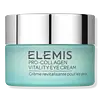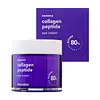What's inside
What's inside
 Key Ingredients
Key Ingredients

 Benefits
Benefits

 Concerns
Concerns

 Ingredients Side-by-side
Ingredients Side-by-side

Water
Skin ConditioningLaminaria Digitata Extract
Skin ProtectingCoco-Caprylate
EmollientChondrus Crispus Extract
Skin ConditioningGigartina Stellata Extract
Skin ProtectingPropanediol
SolventIsononyl Isononanoate
EmollientGlycerin
HumectantButyrospermum Parkii Butter
Skin ConditioningOryza Sativa Starch
AbsorbentCarbomer
Emulsion StabilisingPhenoxyethanol
PreservativeCamellia Oleifera Seed Oil
Skin ConditioningHydroxyacetophenone
AntioxidantPanthenol
Skin ConditioningSodium Polyacrylate
AbsorbentSodium Hydroxide
BufferingSodium Benzoate
MaskingDisodium EDTA
Padina Pavonica Thallus Extract
Skin ConditioningSambucus Nigra Flower Extract
RefreshingPotassium Sorbate
PreservativeRhizobian Gum
Sodium Hyaluronate
HumectantCrataegus Monogyna Flower Extract
Skin ConditioningParfum
MaskingJasminum Sambac Flower Extract
MaskingLactic Acid
BufferingChlorphenesin
AntimicrobialArtemisia Capillaris Flower Extract
Skin ConditioningChlorella Vulgaris Extract
Skin ConditioningCollagen Amino Acids
MoisturisingCitric Acid
BufferingTocopherol
AntioxidantLeuconostoc/Radish Root Ferment Filtrate
AntimicrobialWater, Laminaria Digitata Extract, Coco-Caprylate, Chondrus Crispus Extract, Gigartina Stellata Extract, Propanediol, Isononyl Isononanoate, Glycerin, Butyrospermum Parkii Butter, Oryza Sativa Starch, Carbomer, Phenoxyethanol, Camellia Oleifera Seed Oil, Hydroxyacetophenone, Panthenol, Sodium Polyacrylate, Sodium Hydroxide, Sodium Benzoate, Disodium EDTA, Padina Pavonica Thallus Extract, Sambucus Nigra Flower Extract, Potassium Sorbate, Rhizobian Gum, Sodium Hyaluronate, Crataegus Monogyna Flower Extract, Parfum, Jasminum Sambac Flower Extract, Lactic Acid, Chlorphenesin, Artemisia Capillaris Flower Extract, Chlorella Vulgaris Extract, Collagen Amino Acids, Citric Acid, Tocopherol, Leuconostoc/Radish Root Ferment Filtrate
Collagen Extract
Skin ConditioningVinyldimethicone
Glyceryl Stearate
EmollientNiacinamide
SmoothingPentaerythrityl Tetraethylhexanoate
EmollientButylene Glycol
HumectantGlycerin
HumectantButyrospermum Parkii Butter
Skin ConditioningCetearyl Alcohol
EmollientDipentaerythrityl Hexa C5-9 Acid Esters
Skin ConditioningAdenosine
Skin ConditioningSodium Hyaluronate
HumectantSodium Acetylated Hyaluronate
HumectantHydrolyzed Hyaluronic Acid
HumectantHydroxypropyltrimonium Hyaluronate
Sodium Hyaluronate Crosspolymer
HumectantHyaluronic Acid
HumectantPotassium Hyaluronate
Skin ConditioningHydrolyzed Elastin
EmollientHydrolyzed Collagen
EmollientAcetyl Hexapeptide-8
HumectantCopper Tripeptide-1
Skin ConditioningOligopeptide-29
AntioxidantOligopeptide-32
AntiseborrhoeicPalmitoyl Pentapeptide-4
Skin ConditioningPalmitoyl Tripeptide-1
Skin ConditioningPalmitoyl Tetrapeptide-7
Skin ConditioningPalmitoyl Tripeptide-5
Skin ConditioningC14-22 Alcohols
Emulsion StabilisingC12-20 Alkyl Glucoside
EmulsifyingOctapeptide-7
Skin ProtectingSh-Decapeptide-7
AntioxidantSh-Octapeptide-4
AntioxidantSh-Oligopeptide-9
HumectantSh-Pentapeptide-19
Skin ConditioningPentapeptide-18
Skin ConditioningAcetyl Tetrapeptide-5
HumectantSh-Oligopeptide-1
Skin ConditioningSh-Oligopeptide-2
Skin ConditioningSh-Polypeptide-1
Skin ConditioningSh-Polypeptide-22
Skin ConditioningDipeptide Diaminobutyroyl Benzylamide Diacetate
Skin ConditioningPolyglyceryl-2 Stearate
EmulsifyingStearyl Alcohol
EmollientHydroxyethyl Acrylate/Sodium Acryloyldimethyl Taurate Copolymer
Emulsion StabilisingSqualane
EmollientSodium Polyacrylate
AbsorbentPentylene Glycol
Skin ConditioningCocos Nucifera Fruit Extract
EmollientPinus Sylvestris Leaf Extract
TonicPanthenol
Skin ConditioningWater
Skin ConditioningOctyldodecanol
EmollientCaprylic/Capric Triglyceride
MaskingHydrogenated Lecithin
EmulsifyingPhytosteryl/Octyldodecyl Lauroyl Glutamate
Skin Conditioning1,2-Hexanediol
Skin ConditioningCeramide NP
Skin ConditioningEthylhexylglycerin
Skin ConditioningArginine
MaskingPhytosteryl/Behenyl/Octyldodecyl Lauroyl Glutamate
Skin ConditioningAllantoin
Skin ConditioningAcrylates/C10-30 Alkyl Acrylate Crosspolymer
Emulsion StabilisingPropanediol
SolventCaprylyl Glycol
EmollientChlorphenesin
AntimicrobialDisodium EDTA
Collagen Extract, Vinyldimethicone, Glyceryl Stearate, Niacinamide, Pentaerythrityl Tetraethylhexanoate, Butylene Glycol, Glycerin, Butyrospermum Parkii Butter, Cetearyl Alcohol, Dipentaerythrityl Hexa C5-9 Acid Esters, Adenosine, Sodium Hyaluronate, Sodium Acetylated Hyaluronate, Hydrolyzed Hyaluronic Acid, Hydroxypropyltrimonium Hyaluronate, Sodium Hyaluronate Crosspolymer, Hyaluronic Acid, Potassium Hyaluronate, Hydrolyzed Elastin, Hydrolyzed Collagen, Acetyl Hexapeptide-8, Copper Tripeptide-1, Oligopeptide-29, Oligopeptide-32, Palmitoyl Pentapeptide-4, Palmitoyl Tripeptide-1, Palmitoyl Tetrapeptide-7, Palmitoyl Tripeptide-5, C14-22 Alcohols, C12-20 Alkyl Glucoside, Octapeptide-7, Sh-Decapeptide-7, Sh-Octapeptide-4, Sh-Oligopeptide-9, Sh-Pentapeptide-19, Pentapeptide-18, Acetyl Tetrapeptide-5, Sh-Oligopeptide-1, Sh-Oligopeptide-2, Sh-Polypeptide-1, Sh-Polypeptide-22, Dipeptide Diaminobutyroyl Benzylamide Diacetate, Polyglyceryl-2 Stearate, Stearyl Alcohol, Hydroxyethyl Acrylate/Sodium Acryloyldimethyl Taurate Copolymer, Squalane, Sodium Polyacrylate, Pentylene Glycol, Cocos Nucifera Fruit Extract, Pinus Sylvestris Leaf Extract, Panthenol, Water, Octyldodecanol, Caprylic/Capric Triglyceride, Hydrogenated Lecithin, Phytosteryl/Octyldodecyl Lauroyl Glutamate, 1,2-Hexanediol, Ceramide NP, Ethylhexylglycerin, Arginine, Phytosteryl/Behenyl/Octyldodecyl Lauroyl Glutamate, Allantoin, Acrylates/C10-30 Alkyl Acrylate Crosspolymer, Propanediol, Caprylyl Glycol, Chlorphenesin, Disodium EDTA
Ingredients Explained
These ingredients are found in both products.
Ingredients higher up in an ingredient list are typically present in a larger amount.
This ingredient is also known as shea butter. It is an effective skin hydrator and emollient.
Emollients help soothe and soften your skin. It does this by creating a protective film on your skin. This barrier helps trap moisture and keeps your skin hydrated. Emollients may be effective at treating dry or itchy skin.
Shea butter is rich in antioxidants. Antioxidants help fight free-radicals, or molecules that may harm the body. It is also full of fatty acids including stearic acid and linoleic acid. These acids help replenish the skin and keep skin moisturized.
While Shea Butter has an SPF rating of about 3-4, it is not a sunscreen replacement.
Shea butter may not be fungal acne safe. We recommend speaking with a professional if you have any concerns.
Learn more about Butyrospermum Parkii ButterChlorphenesin is a synthetic preservative. It helps protect a product against bacteria in order to extend shelf life. In most cases, Chlorphenesin is paired with other preservatives such as phenoxyethanol and caprylyl glycol.
Chlorphenesin is a biocide. This means it is able to help fight the microorganisms on our skin. It is also able to fight odor-releasing bacteria.
Chlorphenesin is soluble in both water and glycerin.
Studies show Chlorphenesin is easily absorbed by our skin. You should speak with a skincare professional if you have concerns about using Chlorphenesin.
Learn more about ChlorphenesinDisodium EDTA plays a role in making products more stable by aiding other preservatives.
It is a chelating agent, meaning it neutralizes metal ions that may be found in a product.
Disodium EDTA is a salt of edetic acid and is found to be safe in cosmetic ingredients.
Learn more about Disodium EDTAGlycerin is already naturally found in your skin. It helps moisturize and protect your skin.
A study from 2016 found glycerin to be more effective as a humectant than AHAs and hyaluronic acid.
As a humectant, it helps the skin stay hydrated by pulling moisture to your skin. The low molecular weight of glycerin allows it to pull moisture into the deeper layers of your skin.
Hydrated skin improves your skin barrier; Your skin barrier helps protect against irritants and bacteria.
Glycerin has also been found to have antimicrobial and antiviral properties. Due to these properties, glycerin is often used in wound and burn treatments.
In cosmetics, glycerin is usually derived from plants such as soybean or palm. However, it can also be sourced from animals, such as tallow or animal fat.
This ingredient is organic, colorless, odorless, and non-toxic.
Glycerin is the name for this ingredient in American English. British English uses Glycerol/Glycerine.
Learn more about GlycerinPanthenol is a common ingredient that helps hydrate and soothe the skin. It is found naturally in our skin and hair.
There are two forms of panthenol: D and L.
D-panthenol is also known as dexpanthenol. Most cosmetics use dexpanthenol or a mixture of D and L-panthenol.
Panthenol is famous due to its ability to go deeper into the skin's layers. Using this ingredient has numerous pros (and no cons):
Like hyaluronic acid, panthenol is a humectant. Humectants are able to bind and hold large amounts of water to keep skin hydrated.
This ingredient works well for wound healing. It works by increasing tissue in the wound and helps close open wounds.
Once oxidized, panthenol converts to pantothenic acid. Panthothenic acid is found in all living cells.
This ingredient is also referred to as pro-vitamin B5.
Learn more about PanthenolPropanediol is an all-star ingredient. It softens, hydrates, and smooths the skin.
It’s often used to:
Propanediol is not likely to cause sensitivity and considered safe to use. It is derived from corn or petroleum with a clear color and no scent.
Learn more about PropanediolSodium Hyaluronate is hyaluronic acid's salt form. It is commonly derived from the sodium salt of hyaluronic acid.
Like hyaluronic acid, it is great at holding water and acts as a humectant. This makes it a great skin hydrating ingredient.
Sodium Hyaluronate is naturally occurring in our bodies and is mostly found in eye fluid and joints.
These are some other common types of Hyaluronic Acid:
Learn more about Sodium HyaluronateSodium Polyacrylate is the sodium salt of polyacrylic acid. It is used as an absorber, emollient, and stabilizer.
This ingredient is a super-absorbent polymer - meaning it can absorb 100 to 1000 times its mass in water. As an emollient, Sodium Polyacrylate helps soften and soothe skin. Emollients work by creating a barrier to trap moisture in. This helps keep your skin hydrated.
Water. It's the most common cosmetic ingredient of all. You'll usually see it at the top of ingredient lists, meaning that it makes up the largest part of the product.
So why is it so popular? Water most often acts as a solvent - this means that it helps dissolve other ingredients into the formulation.
You'll also recognize water as that liquid we all need to stay alive. If you see this, drink a glass of water. Stay hydrated!
Learn more about Water